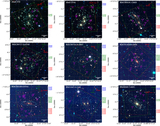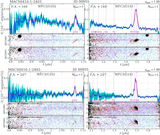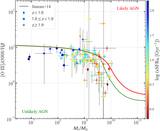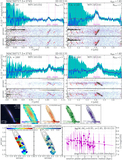Image Details

Caption: Figure 5.
Global properties of our sample. Left: SFR as a function of ﹩{M}_{* }﹩ for galaxies at cosmic noon. Our galaxies are represented by the symbols following the scheme in Figure 4 corresponding to different z bins. However, the color-coding reflects the specific SFR derived from stellar continuum SED fitting after subtracting emission line fluxes (see Section 3.3). The loci of our galaxies are consistent with that of the WISP survey (Henry et al. 2013), if the SFR inferred from dust-corrected nebular emission is adopted. We also show that in terms of mass coverage, our sample is highly complementary to the ground-based mass-complete sample of KMOS3D, which can only probe down to ﹩\sim 5\times {10}^{9}\,{M}_{\odot }﹩ at z ∼ 2. Right: MZRs for high-z galaxies. The symbols of our sample now have the same color-coding as in Figure 4. Our galaxies follow similar trends of the MZRs from the WISP survey and Maiolino et al. (2008). In the low-mass regime (﹩{M}_{* }\lesssim {10}^{8}\,{M}_{\odot }﹩), our galaxies are more metal-enriched than the simple extensions of those MZRs. These metal-enriched galaxies also have higher sSFRs than the sample average.
Copyright and Terms & Conditions
© 2020. The American Astronomical Society. All rights reserved.













